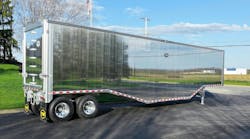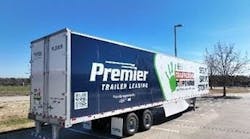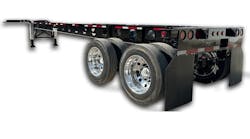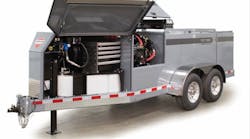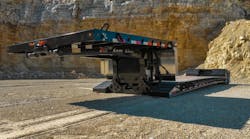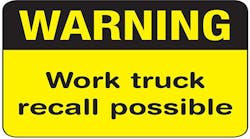RECALLS are a common—and, some would say, too common—part of the transportation industry. In 2014, 16.5 million vehicles were sold—and 64 million vehicles were recalled.
Most people hear about recalls and think about the chassis manufacturer. But what about upfitter, a final-stage manufacturer, an alterer? Does this apply to them?
Bob Raybuck, director of technical services for the National Truck Equipment Association (NTEA), provided a detailed road map in his webinar, “Are Equipment Recalls Your Responsibility?”
“Many final-stage manufacturers believe only the chassis manufacturer is responsible for recalls,” Raybuck said. “But as a final-stage manufacturer, you are responsible for the equipment you install and the subsequent recall of this equipment.
“What are recalls? It’s about vehicle safety itself. Vehicle and equipment recalls occur because the vehicle and equipment pose a risk to motor vehicle safety. It’s not just violating Federal Motor Vehicle Safety Standards, but it’s about the overall vehicle on public roads, and is it safe? There could be an issue in equipment based on the design and manufacture that could potentially cause a safety risk.”
Examples of equipment recalls from 2014 in the work truck industry that were initiated more because of equipment failure and not because of chassis-related issues:
• A defective valve in a hydraulic system used to operate a piece of equipment caused fluid leaks—a safety hazard.
“The issue wasn’t that the leaks were not good environmentally, but more important, how did this affect things on the safety side? The fluid leaks were in an area that could have caused bad, slippery issues for the vehicle maintaining control. It could have changed the stopping distance. And worse, if it leaked into the exhaust system, it could have caused smoke and even a possible fire. The company in question who made the valves initiated part of it and informed a lot of companies that purchased that valve about the issues because they couldn’t get in touch with the individual chassis owners themselves.”
• Wiring problems resulted in the loss of required lights, creating a vehicle safety hazard.
• Failure of components like latches and hinges caused parts of the vehicle or payload to fall off, posing a roadway hazard.
“They would vibrate and crack based on their attachment design and build, and have a variety of different issues—between having tailgates fall open, payload fall onto the roadway, causing a hazard, to tailgates on trailers falling over and scraping the ground and causing sparks, and even hinges and doors falling open themselves,” he said.
• Cracks in equipment (i.e., wheelchair lifts) prompted a recall.
“There is specific equipment that has FMVSS standards themselves,” he said. “In the past year, there was a manufacturer that had vibration and issues and concerns about cracks that were starting. They wanted to bring the units in and get them repaired because they understood, ‘I want to be overly cautious. I’m lifting handicapped people on a wheelchair. I want to make sure this works properly.’”
Is it safety-related?
Examples of defects not considered safety-related and are more customer-care issues:
• Air conditioners and radios that do not operate properly.
• Ordinary wear of equipment that must be inspected, maintained and replaced periodically—including shock absorbers, batteries, brake pads and shoes, and exhaust systems.
• Nonstructural or body panel rust—as compared to what would be considered an issue, such as rust on a truck frame that causes cracks.
• Quality of paint or cosmetic blemishes.
• Excessive oil consumption within the engine, not necessarily oil leaking inside.
If one of your equipment manufacturers tells you he has an issue and needs to do a recall or customers are complaining, how is a recall initiated?
• Voluntary recall. It is initiated by the equipment manufacturer or final-stage manufacturer, and results from consumer complaints.
• Initiated by National Highway Traffic Safety Administration (NHTSA) investigation from complaints.
“NHTSA screens consumer complaints for alleged defects and analyze petitions calling for defect investigation,” Raybuck said. “They investigate the issue to determine if there is a defect and a recall is warranted.
“Depending upon the size of the company, there are early-warning reporting requirements for a lot of these complaints or when information comes into NHTSA itself. Many in our industry are small enough that they don’t have a lot of early-warning reporting requirements, but there are certain groups that have that regardless of vehicle size, like transit bus applications.”
Voluntary recalls
Raybuck said that with a voluntary recall, the equipment manufacturer or final-stage manufacturer (multi-stage manufacturer) determines there is a safety concern and initiates a recall.
“If there is a bad component part like a hinge that is breaking, not due to being too old, but you’re seeing cracks and other issues causing concern from normal usage,” he said. “You’ve never had this problem before. What would you do as a final-stage manufacturer or component supplier?
“You’d notify NHTSA with a Defect and Non-Compliance Information Report: ‘Here we have this concern, this is what we’re looking at, and we’re concerned enough to start looking at initiating a recall.’ Once the defect has been determined, the manufacturer has five working days to notify NHTSA. Submit a description of the remedy plan—how I’m planning to let customers and owners of that equipment know how I’m going to deal with this issue.”
NHTSA and the Office of Defect Investigation (ODI) will review the defect report.
“They will look at it for completeness and to make sure you have isolated the issue or found out what the issue was and come up with a good plan for recalling vehicles,” he said. “If they agree with you and find it to be a safety defect, they will issue a Safety Recall Identification Number that you use with all documentation in announcing to the public and your consumers.
“The manufacturer may be given a brief opportunity to review the ODI summary. They’re going to look to make sure it’s complete or if they have any other concerns. Or if you’ve come up with something new since you released the report to them. The safety recall information is then made public. You’ve been gathering information as to who has the vehicles with the equipment and how you’re going to get in touch with them so you can make the information available to them.”
Letting owners know
After that, develop a plan to notify owners of the recall.
“For multi-stage manufactured vehicles, only one manufacturer needs to notify owners,” he said. “If it’s a chassis-related issue or an issue from one of the major OEMs and they made an announcement to all owners, that’s fine for you as a multi-stage manufacturer. Or let’s say it was a component parts supplier and a hinge manufacturer used your information of who you sent it to to notify all the owners that there was a recall, and they took it on as their responsibility, as opposed to working with you.
“Make owners aware of available repairs. Bring it in to whatever location, let them know parts are available and here’s the time.
“Inform owners of potential risks if their vehicles are not repaired in a timely fashion, and what the risk actually is. As we can see with the number of recalls in the past year, a lot of people have been potentially touched with recalls on their personal vehicles. And in some cases, you look at the recall and say, ‘That’s important. Do I have to stop driving the vehicle?’ If your seat belt system doesn’t work properly, you will have a high concern and want to get it repaired as soon as possible—as compared to rear-window switches that may not work properly. That’s not as timely. It’s important that with your notification, you give them an idea of how big of a safety issue this is.”
New requirements
Raybuck also noted that in the past year, changes were made that require new information for the recall envelope.
So you’ve gone through the entire process: determined there was an issue, notified NHTSA, started notifying customers, bringing vehicles in, and getting them repaired. Now you need to document it properly to NHTSA.
“In the work truck industry, a lot of customers take their vehicles to work,” Raybuck said. “They might have a vehicle out in the oil fields that does not come in for three or four months. This recall issue might be a driveable issue and the customer might go, ‘OK, we’re not driving this vehicle but it’s a mechanical use of it’—whether it’s a crane vehicle or well-drilling vehicle that doesn’t move once it’s on the job site. They may be looking to say, ‘I need free time to get this vehicle in for a recall.’ NHTSA will be looking for status reports. You have to keep notifying the owner that there is an additional piece of information: ‘We need you to actually come in and take care of it.’ The goal is always 100% recall compliance.”
Raybuck stressed the need to keep records of repaired vehicles and share recall notification with NHTSA. NHTSA will require reports on recall and remedy progress in the form of quarterly status reports, and the owners must receive multiple notifications.
Then there’s a complete recall.
“For most truck equipment houses and upfitters, you’re generally not going to have a large number of vehicles like a major OEM that sells millions of vehicles per year,” he said. “You might be doing hundreds. You must keep records of all recall documentation. How often did you try to get information out? What vehicles came in? You must maintain records for a minimum of five years.”
Options for manufacturers:
• File for inconsequential non-compliance.
“If the violation is minor and does not affect vehicle safety, the manufacturer can file for inconsequential non-compliance,” he said. “Examples of past inconsequential non-compliance: tires labeled with ply ratings incorrectly; certification labels without metric units; tire and loading information labels without correct payload capacities.”
Stages in a NHTSA investigation:
• Preliminary evaluation.
“Review complaints, review warranty claims, review crash and injury data, and if further investigation is required, move to an engineering analysis.”
• Engineering analysis.
“The Office of Defect Investigation (ODI) reviews inspections, tests, and surveys.”
When NHTSA sends a recall request, the manufacturer receives a recall request from ODI. The manufacturer can challenge the recall request in court or proceed with the recall.
Recall management notifies vehicle and equipment owners, along with dealers and distributors.
You follow a similar procedure to a voluntary recall. Notify NHTSA with a Defect and Non-Compliance Information Report. Once the defect has been determined, the manufacturer has five working days to notify NHTSA. Submit description of remedy plan. Keep records. And close the recall.
The manufacturer must repair the defect free of charge to the owner, and must also reimburse for an already-repaired defective item.
Raybuck gave some resources for manufacturers:
• 49 Code of Federal Regulations (CFR) Part 573 Defect and Non-Compliance Responsibility and Reports.
• 49 CFR Part 577 Defect and Non-Compliance Notification.
• 49 CFR Part 579 Reporting of Information and Communication about Potential Defects.
• NHTSA Recall Compendium.
• Consumer information is available at safercar.gov.
• The NHTSA Recall Compendium is available at
www-odi.nhtsa.dot.gov/recalls/documents/recompendium.pdf
• 49 CFR is available at www.gpo.gov/fdsys/browse/collectionCfr.action?collectionCode=CFR
